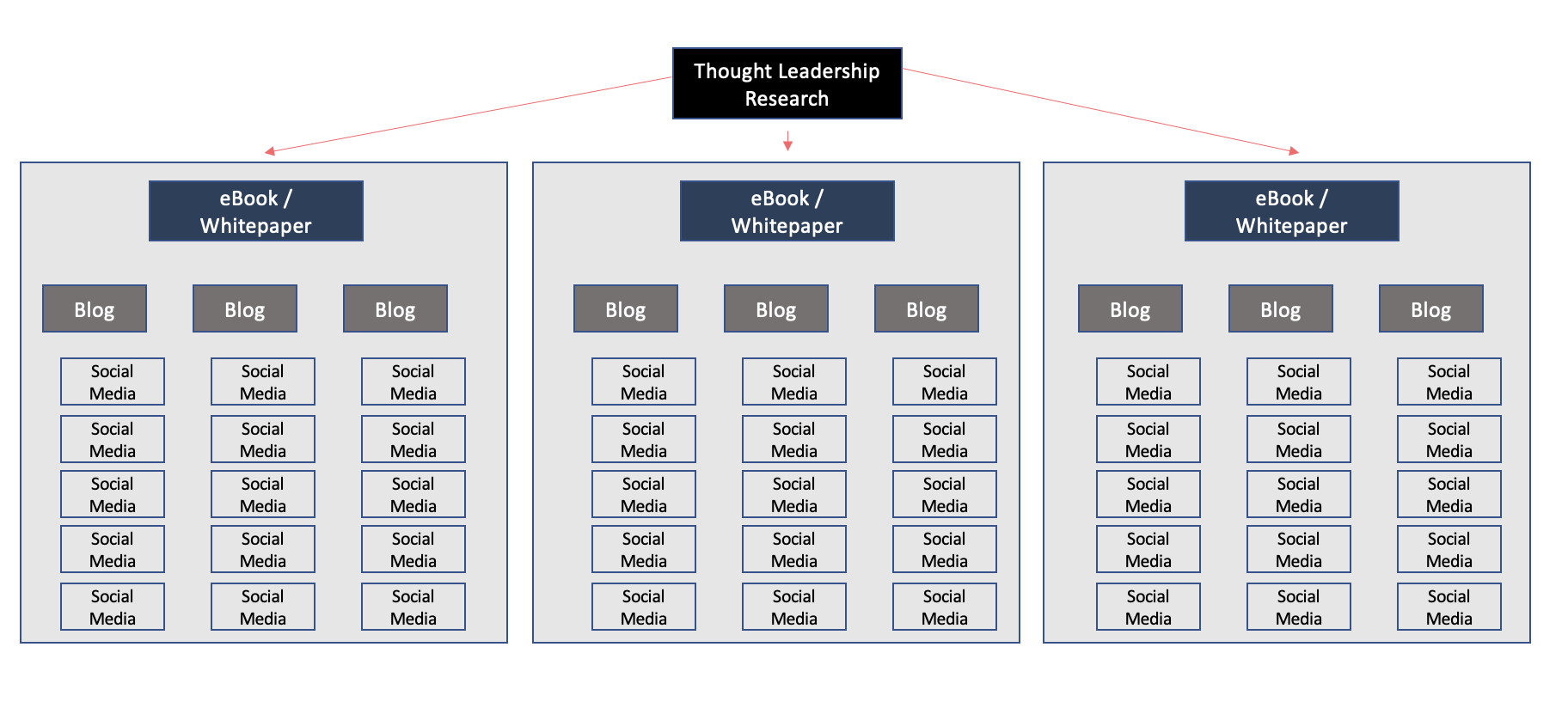We are huge fans of using thought leadership research to drive marketing wins. So much so that we eat our own dog food and publish this type of work on a regular basis.
Why?
Because thought leadership research builds the foundations for marketing activities like awareness-driving SEO and PR as well as consideration-generating content and social media. With the right pre-planning and execution, just one thought leadership report powers months of marketing efforts and new customer acquisition.
The Benefits Of Thought Leadership Marketing
When we talk about thought leadership marketing, we’re talking about content formed by primary research. Said more simply, it’s creating a research report fueled by original data you source.
It’s extremely powerful because it targets everything from lead generation to longer-term nurturing activities.
• PR: Magazines, newspapers, and online outlets have to publish new articles daily. Giving them original research and data is an excellent way to get them to talk about you and your work. Here’s an example of a PR hit from one of our original research reports.
• Organic Search: You want to get found on popular search engines by people looking for what you have to offer. Digitally publishing content helps do just that. Also, those press hits you get link directly to your website. This also helps search engines like Google prioritize showing your website.
• Multi-Channel Content: Businesses need interesting content to populate email, blog, and social media channels. Creating and sharing original research across these channels serves that purpose beautifully.
In essence, you get a ton of bang for your buck with original, research-based marketing activities.
Where To Use Thought Leadership In Content Marketing Materials
Let’s look at the benefits of thought leadership in terms of fueling a content marketing engine for your organization.
As you’ll see in the image to the right, original research drives cascading content generation. At the top is the original research itself, usually in the form of a published research report.
A single report frequently spurs a series of eBooks and white papers. This is because the initial report uncovers a variety of novel, independent ideas. Each idea serves as its own longer-form content piece. From there, you can slice and dice each of these pieces into shorter blog posts. Lastly, each blog post drives 4-5 distinct social media posts across channels.
At each stage, you need to assess how best to parse bigger, longer-form content into smaller content. By doing so, an organization enjoys month’s worth of content material.

How To Do Thought Leadership Research
Let’s go through the step-by-step process required to produce a thought leadership report in the first place. This involves everything from early ideation and research method design to collecting data and reviewing results.
1. Select A Key Theme
Out of the gate, you need to pick an overarching theme for your research. There are a few different ways to choose a theme:
• Seasonality: Consider using annual milestones like holidays, industry conferences, or other major events to drive your research themes. By releasing your report right before these milestones, you can be assured that your report aligns with what customers have top-of-mind.
• Topicality: Relatedly, look for major topics hitting the general news. Contributing to the topic with your own research fuels conversation and, once again, makes your research relevant to talk about.
• Industry Issues: If there are topics particularly pertinent to your industry (e.g. technology, disruptors), consider using those as core themes.
Whatever theme you choose, make sure it ties in to something relevant for your audience. You want to publish something that people want to read and talk about.
2. Develop Survey Questions
Once your theme is ready, it’s time to draft out the survey questions. As you do this, remember your end goal: to create interesting, though-provoking findings. This means crafting questions that lead to these types of findings.
3. Consider Unique Sub-Groups Or Segments
How different groups react to questions often spurs unexpected findings. Be sure to include demographic questions to let you “read” the data by these groups. For B2C surveys, consider age, race/ethnicity, household income, and employment status. For B2B questions, consider industry, role, seniority-level, or annual budgets.
4. Program The Thought Leadership Survey
While not always, thought leadership research typically means quantitative research. This means programming your survey questions into a digital platform that enables data collection.
5. Collect Responses
Once your survey is ready, it’s time to get people to take it! If your research is B2C, we suggest a sample size of 1,000 respondents or more. For more niche populations, this number can come down to 500. Meanwhile, for specialty B2B surveys, we aim for 250 respondents.
You’ll have to source your participants from somewhere. Two standard approaches include:
• Customer Database: If you have a robust contact database, use it! It’s a cost-effective way to recruit participants.
• Research Panels: A secondary option is leveraging research panels. Panel companies specialize in building databases of people who have opted-in to participating in assorted research like surveys and interviews.
6. Analyze The Results
With the data collected, it’s time to look at your results. We suggest using a wide variety of statistical analyses, correlations, and multivariate regressions to uncover interesting findings.
Also, don’t forget to look at your results by those distinct segments! Sometimes the most unexpected findings come by doing just that.
Crafting Your Final Thought Leadership Report
With your results in and analyzed, you’re nearly at the finish line. Now it’s time to pull everything together into a final report.
Sure, this means doing a full write up. That said, keep a few things in mind. First off, make it approachable! Use direct, simple language. Jargon and lengthy sentences will lose your audience immediately.
Additionally, we suggest two areas to really focus on when structuring your report:
• Key Findings: Pick 5-7 really interesting, attention-grabbing findings. Put these at the very top of your report in short bullet point phrases. This makes your content skimmable and makes the really good tidbits hard to miss.
• Compelling Charts & Graphs: Take the extra time and effort to make good-looking charts and graphs. As images, this is what will catch readers’ eyes the most. Think through the titles and subtitles of each image very carefully. Just as with the key findings bullet points, good titles make your core messages stand out.
When you think you’re done, share your report with a few trusted readers. A fresh set of eyes is the best way to verify that it’s straightforward, succinct, and includes compelling information.





